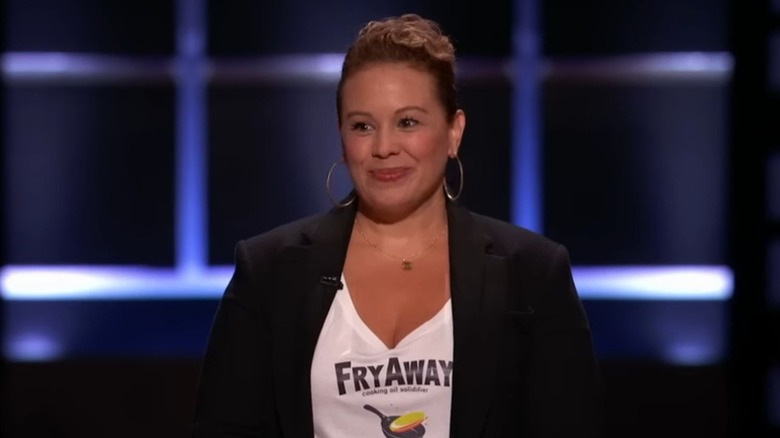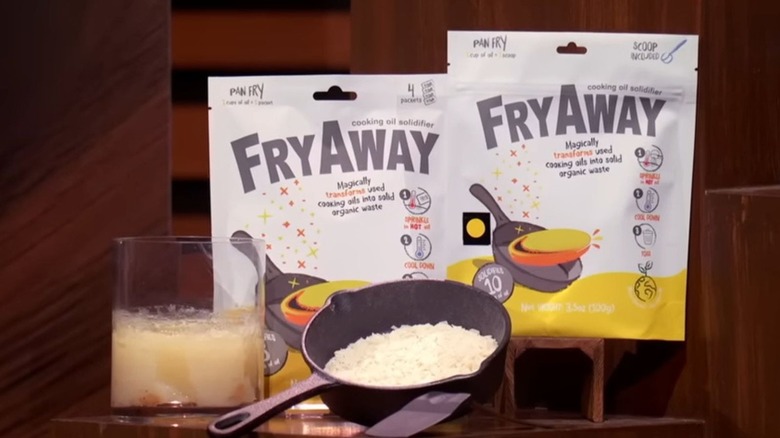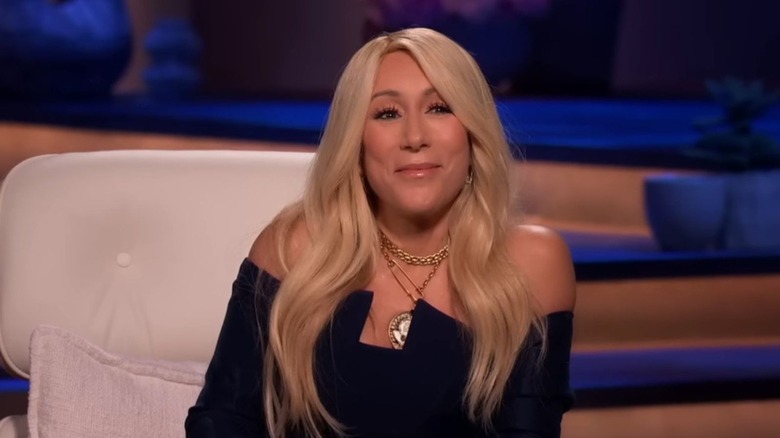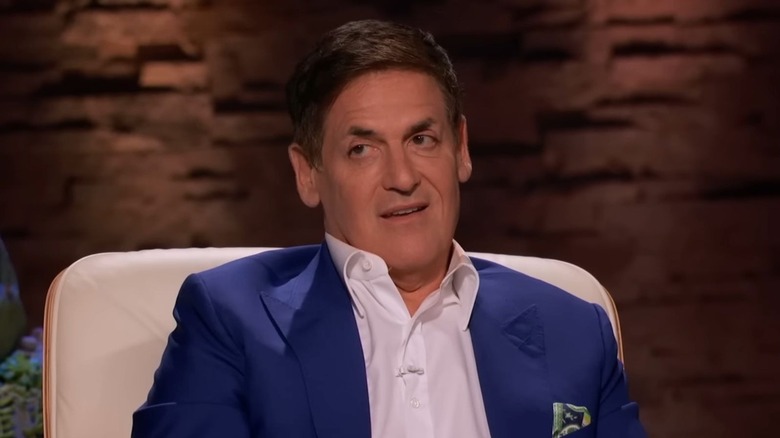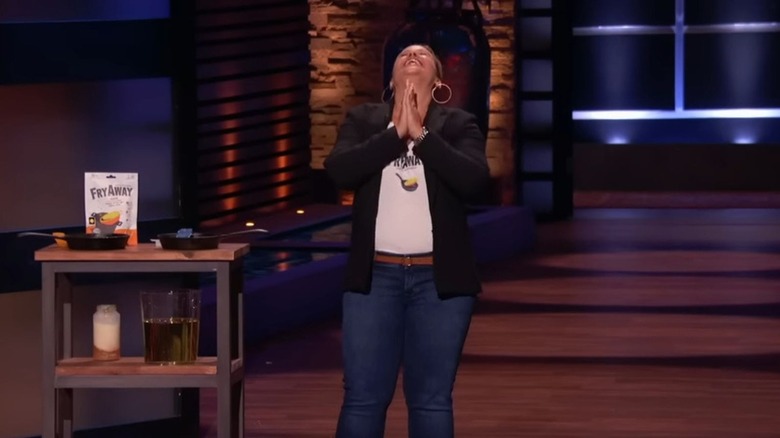Whatever Happened To FryAway After Shark Tank?
We may receive a commission on purchases made from links.
Fried "Shark" anyone?
Fans of homemade crispy dishes have long been plagued by the unavoidably frustrating clean-up process that stems from the unused cooking oil sloshing around in their pans. Though it might seem reasonable to pour it down the drain like other liquid waste, the fat is liable to build up in the pipes and cause expensive and potentially dangerous damage down the line.
Thus, career marketer and hopeful entrepreneur Laura Lady wanted to solve this problem with her product, FryAway. The wildly popular ABC reality investing program "Shark Tank" invited Lady to come on the show after catching wind of her product and she took the opportunity. A second-generation American whose family immigrated from Honduras, Lady explains that she can't help but want to solve a problem when she recognizes one — whether she's solving an issue in her own manufacturing or solving one of the peskiest food-waste issues ever known.
Lady brought FryAway on "Shark Tank" for Season 14, but — as we learned with Amber — an invitation to pitch far from signals that a product will be met with a warm reception, much less a deal.
FryAway ordered two Sharks to-go
Laura Lady enters the "Shark Tank" seeking $250,000 in exchange for 10% of her company, FryAway. The titular product is essentially a bag of powder that, when poured into unused cooking oil, turns the harmful liquid into a gelatin solid that can be thrown in the trash can, keeping it out of your pipes. This process is called oleogelation, which America's Test Kitchen describes as a relatively recent development in food science that's primarily popular in Japan.
Just as impressive as FryAway's science is the company's sales. Two months into business, the company is already profitable with zero debt. Lady has taught herself how to manufacture the product in her garage for a tenth of what she sells it for, though much of her revenue is spent on advertising.
Despite the delicious pitch, most of the Sharks bow out, citing a lack of interest in being involved in fried foods. Mark Cuban starts to do so, as well, though Lady's enthusiasm for his involvement ultimately brings him back in. Ultimately, FryAway nabs a deal with both Cuban and Lori Greiner for $250,000 in exchange for 22%.
FryAway made a decent splash after its pitch
After appearing on "Shark Tank," FryAway garnered favorable media coverage for its ingenuity, unique functionality, and potential positive impact on the environment. Food and Wine profiled the company in their "Game Changers" column, while Green Matters provided an in-depth look at how using FryAway reduces the potential for oily disasters and discarded plastic materials; a popular method for disposing of oil is to store it in a plastic bottle, which will take hundreds of years to decompose. At the end of 2023, BuzzFeed ranked it as one of the top 17 "Shark Tank" products of the year.
That said, FryAway's social media presence leaves a lot to be desired. On Instagram, it still has yet to crack 5,000 followers, despite posting fairly regularly. Meanwhile, on Facebook, it has fewer than 500 followers. Without the social media benefits of the "Shark Tank Effect" or a free following to market toward and educate, it seems as though the company may have to continue taking out those pricey Amazon ads that decimate its revenue. This would be especially true if it was unable to close its deal with Mark Cuban and Lori Greiner.
FryAway likely didn't close it's Shark Tank deal
FryAway may have looked like a hot product during its "Shark Tank" pitch, but it seems to have gotten the cold shoulder by the investors who offered to join the team. On Lori Greiner's website, she features a collection of her most successful "Shark Tank" products — and FryAway is nowhere to be found. The company is also not listed among Mark Cuban's "Shark Tank" investments on his own website, which is more comprehensive than Lori's. FryAway's absence from both sites after over a year since the pitch likely indicates that the company's deal may have fallen apart at some point during negotiations.
While there is no official record of why Cuban and Greiner may have pulled out of the FryAway deal, it would almost certainly have something to do with information learned after the taping. One glaring issue we can see is that the FryAway product seems to have a lot in common with popular oleogel products outside the U.S., which may mean the product was unable to obtain a patent or was too replicable. After all, the Sharks have historically been wary of simple yet ingenious products that could easily be copied by larger companies after the real pioneer does the hard and thankless work of educating consumers.
All that being said, FryAway is still in business at this time, even though its method of oil disposal has yet to catch on in the U.S. The product is available on Amazon and the FryAway website in three different sizes and boasts thousands of five-star ratings.
Can FryAway survive much longer?
The bad news is that FryAway's business will be existentially in jeopardy the moment any large baking company recognizes a common and financially beneficial desire to use this method of oil disposal amongst the general public. Unless FryAway is able to secure some kind of patent or other protection of its primacy, nothing would stop Betty Crocker or Crisco from dominating the market overnight.
The good news is that Laura Lady's business model has been trimmed of all possible fat (save for the advertising), meaning that she can essentially keep it running at cost for as long as she likes. Perhaps if she stays in the game long enough, FryAway can steadily become a more formidable brand that could survive the competition. Given that neither the company nor the method skyrocketed in popularity after being broadcast to millions on ABC, it just seems unlikely this will occur without a sizable stroke of luck.
